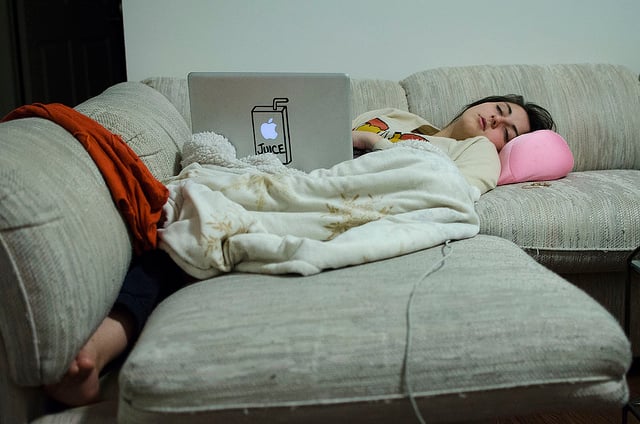
In recent articles, I have discussed the importance of sleeping in a completely dark room with no ambient light to support the maximum production of melatonin.
Melatonin is a hormone produced by the pineal gland, and it is much more than just a sleep hormone.
Like the janitor who comes in at night to clean the floors and wash the windows, melatonin is the body’s most powerful detoxification and rejuvenation agent.
While the role melatonin plays in our health is still not fully understood, studies suggest that without a good dose of daily sun exposure, we do not produce optimal levels of melatonin. Sadly, modern humans are getting too much light at night and not bright enough light during the day.
In one study conducted in sunny San Diego, California, an average, middle class, middle-aged adult spent less than four percent of their time (or 58 minutes) outdoors—and much of that time was spent in their car. People in less sunny climates generally spend more time indoors. Unfortunately, shift workers are only exposed to the bright light that is needed for optimal health for 2.6 percent of their waking hours.
In the winter, people spend most of their time indoors in front of televisions, playing video games, on computers, or screens of any kind, resulting in a dangerous drop in melatonin production.
Bright Sunlight Boosts Melatonin.
In Dr. Russel Reiter’s book, Melatonin, a Finland study evaluated two groups of rodents who were exposed to either natural sunlight or fluorescent light.
One group received fluorescent lighting, and the other group received natural sunlight.
Both groups experienced the same amount of daily sunlight, and both groups experienced the same amount of darkness throughout the night.
After one week, the researchers measured the melatonin levels of the two groups and came up with a significant finding: The rodents who were given sun exposure produced far more melatonin at night than the ones in the artificially-lit room.
The study found that it was not the fluorescent light that produced some negative or toxic effect on the body. It was simply that the fluorescent lights were not bright enough compared to natural sunlight.
The brightness or intensity of light is measured in lux. For example, 100 lux is the amount of light that would enter your eyes if you were looking at a 100-watt light bulb from a distance of five feet in an otherwise dark room.
The fluorescent lights, during this study, delivered about 400 lux, which is brighter than most indoor environments. The light in the sunlit room varied from dawn to dusk and peaked at about 3,000 lux during the day—which is more than seven times the light brightness of the fluorescent bulbs.
The research concluded that it was the brightness or intensity of the light during the day that delivered a boost in melatonin levels at night.
The Takeaway.
If you are looking for a better night’s sleep, or to boost the benefits of melatonin as an antiaging and detoxifying hormone, the amount of sunlight you get during the day is as critical as the amount of darkness you get at night.
Most people with sleep imbalances put a lot of energy into eye masks or shades that completely block out any ambient light from their bedroom, but they may not be putting the same amount of attention toward getting the daily sunlight they need to produce optimal melatonin levels.
The researchers also discussed that the variation of light intensity during the day from dawn to dusk may also play a role in the circadian release of melatonin at night.
In this study, at sunrise, the fluorescent light switch was turned on and the same intensity of light was experienced by the rodents until sunset, when the fluorescent lights were switched off.
Once again, we are confronted with how our artificial environments may be disturbing our precious circadian rhythms.
In a handful of studies at the University of California, San Diego, researchers found that women with premenstrual syndrome (PMS) had chronically low levels of melatonin. When these women were exposed to just two hours of bright light during the day, they produced more melatonin at night and saw significant changes in there premenstrual symptoms. (1)
In another study, researchers compared the intensity of indoor light to outdoor light during different times of the day. During a sunny day, lux levels reached 50,000, compared to indoor lighting levels, which were consistently in the mere hundreds—suggesting that the amount of intensity of outdoor sunlight is significant in comparison to what we commonly experience indoors. (1)
Once again, we must get outside, particularly during the long, bright, and sunny days of summer.
In a study conducted in Germany, 30 subjects with mood imbalances underwent one week of light therapy. Before the light therapy, only 21 percent of the subjects had a balanced or healthy level of melatonin. After the therapy, 47 percent of the subjects experienced healthy and balanced levels of melatonin.
In another study with folks suffering from sleep conditions, researchers saw a 160 percent increase in melatonin during the night after being exposed to just a half an hour of bright light coming from a light box.
Bottom line: A good night’s sleep may have more to do with what we do when our eyes are open, than when they’re shut!
~
Reference:
1. Reiter, R. Melatonin. Bantam books, NY. 1996. P.213
~
Author: Dr. John Douillard
Image: Emma Fierberg/Flickr
Editor: Leah Sugerman
Copy Editor: Yoli Ramazzina
Social Editor: Yoli Ramazzina








Read 9 comments and reply